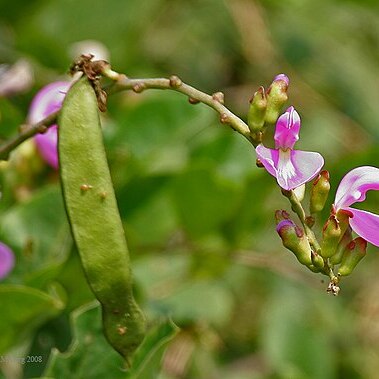Herbs, perennial, twining. Leaflets ovate or obovate, 6-14 × 4-10 cm, sparsely pubescent on both surfaces, base truncate or cuneate, apex rounded or cuspidate. Racemes axillary. Calyx ca. 12 mm, pubescent, upper lip broadly 2-lobed and lobes apiculate at apex, lower lip 3-lobed, small, subtruncate. Corolla purplish red; standard broadly ovate, ca. 2.5 cm, emarginate, base with 2 thickenings, auriculate; wings linear-oblong, slightly falcate; keel obovate-oblong. Legumes oblong, compressed, 6-10 × 2.5-3 cm, each valve with extra rib ca. 3 mm from sutural rib. Seeds brown, 2 or 3, ovate, ca. 1.7 × 0.7 cm, blotched. Fl. and fr. Jun-Oct.
More
A twining herb. It keeps growing from year to year. The leaves are oval and 6-14 cm long by 4-10 cm wide. They are softly hairy. The base is wedge shaped and it is rounded at the tip. The flowers are on the axils of leaves. They are purplish red. The fruit is an oblong pod 6-10 cm long by 3 cm wide. The seeds are brown. There are 2 to 3 oval seeds.

